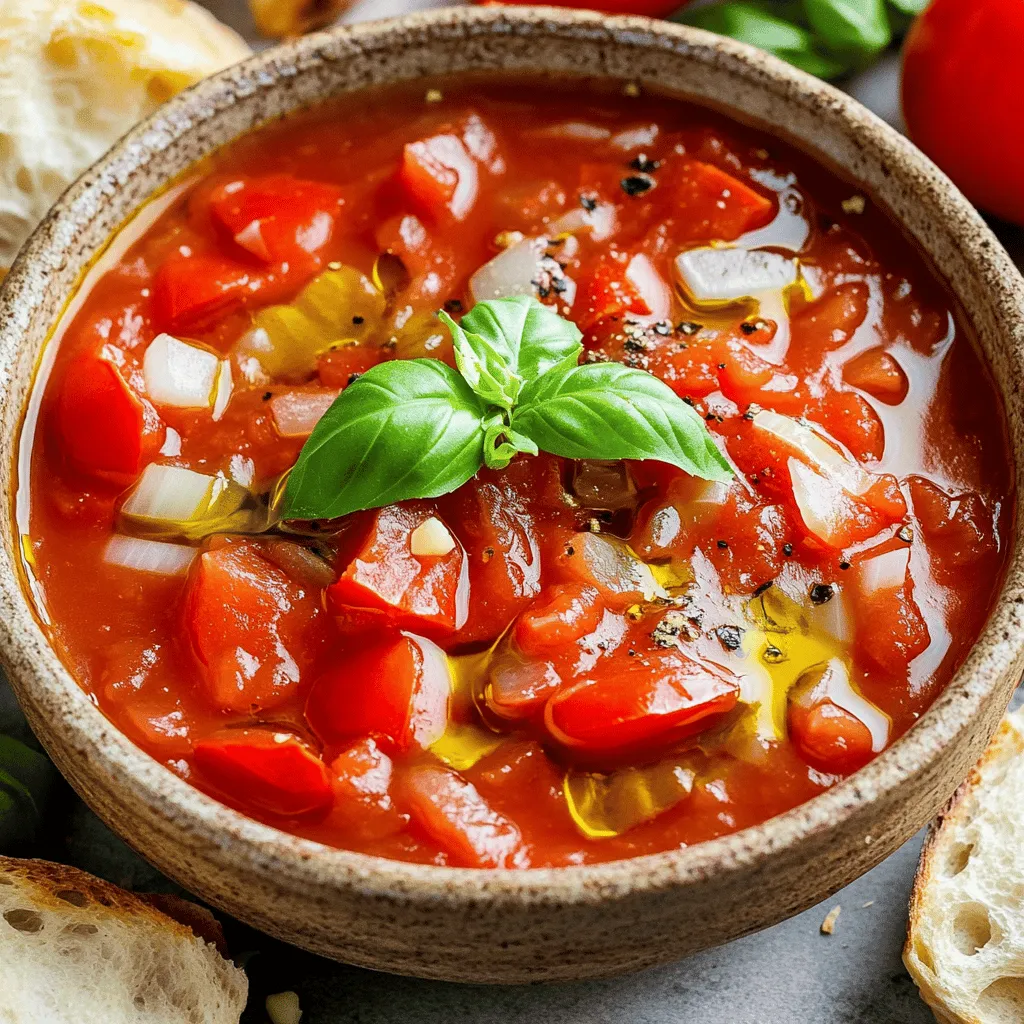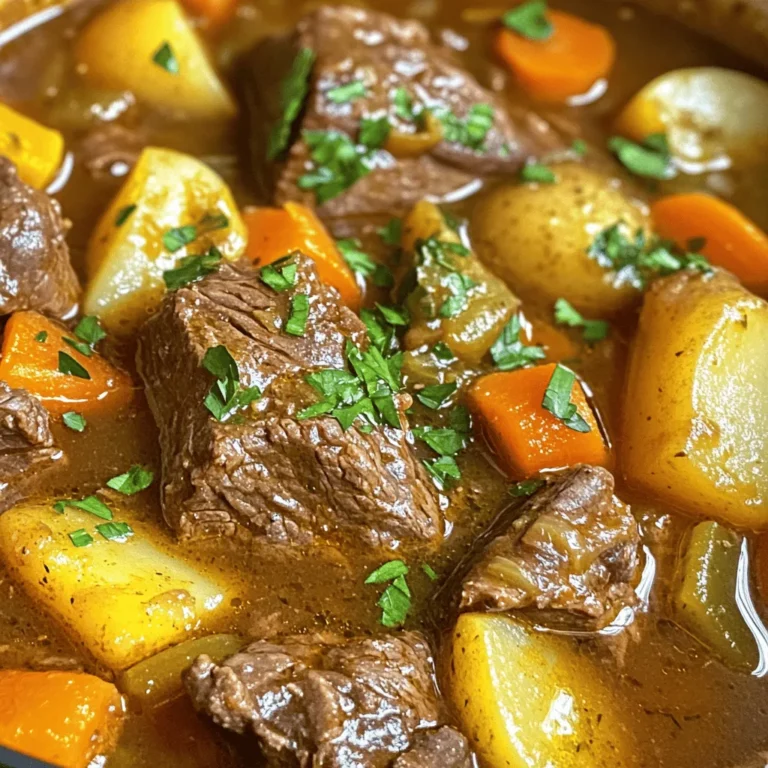Homestyle Canned Tomato Sauce Flavorful and Fresh Recipe
 for more details and tips! Cooling your sauce is key before storing it. If you skip this step, you risk spoilage. Let your sauce cool to room temperature for about 30 minutes. This helps keep bacteria away. For storage, use airtight containers. Glass jars or plastic containers work well. Fill them, leaving some space at the top. This room allows for expansion during freezing. You can keep your tomato sauce in the fridge for about one week. After that, it may lose flavor and freshness. Always check for signs of spoilage. If you see mold or notice off smells, toss it out. Safety first! Freezing is a great option for long-term storage. You can pour your cooled sauce into freezer bags or containers. Make sure to label them with the date. This keeps your freezer organized. Aim to use your sauce within six months for the best taste. After this time, it may lose flavor. When ready to use, thaw it overnight in the fridge or heat it directly from the freezer on low heat. For homestyle canned tomato sauce, I recommend using Roma tomatoes. They have fewer seeds and thicker flesh, which gives you a rich sauce. Heirloom tomatoes are also great. They offer unique flavors, but they can be juicier. Choose what you like best! Yes, you can use canned tomatoes. They are convenient and save time. Canned tomatoes are often picked at peak ripeness, giving you good flavor. However, they may contain added salt or preservatives. This can change the taste of your sauce. Always check the label before using! If your sauce is too thin, there are easy ways to fix it. First, let it simmer longer. This allows excess water to evaporate. You can also add tomato paste. It thickens the sauce and adds more flavor. Another option is to use a blender for a smoother texture. Try these methods to get the right thickness! In this blog post, I shared how to make homestyle canned tomato sauce. We covered key ingredients like ripe tomatoes, onion, and olive oil. I provided step-by-step instructions for preparing, sautéing, and simmering. You learned tips for perfecting the sauce and several tasty variations. Finally, I gave guidelines for storage and answered common questions. Making your sauce allows for creativity and customization. Enjoy the process and the flavors you create!](https://fastmealmate.com/wp-content/uploads/2025/07/d3d80814-eb56-4e2c-a9cc-6b13653587fc.webp)
Are you ready to make a fresh, flavorful homestyle canned tomato sauce? This easy recipe uses ripe tomatoes, garlic, and onion to create a rich, tasty sauce you can enjoy year-round. Whether you want to complement your pasta or a cozy dish, I’ll guide you through each step. Let’s dive in and transform simple ingredients into something delicious and memorable!
Ingredients
Main Ingredients for Homestyle Canned Tomato Sauce
– 4 pounds ripe tomatoes, roughly chopped
– 1 large onion, finely diced
– 4 cloves garlic, minced
– 2 tablespoons extra virgin olive oil
The key to my homestyle canned tomato sauce starts with ripe tomatoes. They bring natural sweetness and bright flavor. Onions add depth, while garlic gives it a lovely aroma. Olive oil helps bind the flavors and adds richness.
Seasonings and Optional Ingredients
– 1 tablespoon sugar (optional, for balancing acidity)
– 1 tablespoon dried oregano
– 1 tablespoon dried basil
– 1 teaspoon red pepper flakes (optional, for a spicy kick)
– Salt and pepper to taste
Seasonings turn simple sauce into something special. I often add sugar to cut the acidity of tomatoes. Oregano and basil offer classic Italian notes. Red pepper flakes can add a fun heat, perfect for those who like spice.
Garnish Suggestions
– Fresh basil
– Serving pairings like pasta or crusty bread
A garnish of fresh basil brightens the dish. You can serve this sauce with pasta, on pizza, or alongside crusty bread. Each option adds a different layer of enjoyment to the meal.
Step-by-Step Instructions
Preparing the Tomatoes
Skin Removal Techniques
To start, you may want to remove the skins for a smooth sauce. First, score the bottoms of the ripe tomatoes with an X. Then, blanch them in boiling water for 30 seconds. Quickly move them to an ice bath to stop the cooking. After cooling, the skins will come off with ease.
Chopping Instructions
Once peeled, chop the tomatoes into rough pieces. You can leave the seeds if you prefer a chunkier sauce. Set the chopped tomatoes aside for later use.
Sautéing the Vegetables
Onion Preparation and Cooking Time
In a large pot, heat two tablespoons of olive oil over medium heat. While the oil warms, finely dice one large onion. Add the onion to the pot and sauté it for about five minutes. Stir it often until it turns soft and translucent.
Adding Garlic for Flavor Boost
Next, add four minced garlic cloves to the pot. Stir them in and cook for another one to two minutes. Be careful not to let the garlic burn. Burnt garlic can ruin the sauce’s taste.
Combining and Simmering
Mixing Ingredients for Optimal Flavor
Now, it’s time to add those chopped tomatoes. Toss them into the pot along with one tablespoon of dried oregano, one tablespoon of dried basil, and salt and pepper to taste. If you like a hint of sweetness, add one tablespoon of sugar. Stir everything together well.
Adjusting Heat and Cooking Duration
Bring the mixture to a gentle simmer. Lower the heat to maintain a steady bubble. Let it simmer uncovered for 45 minutes to 1 hour. Stir it occasionally. The sauce will thicken and flavors will deepen. Adjust the cooking time based on how thick you want your sauce.
Tips & Tricks
Perfecting Your Tomato Sauce
Temperature Control for Simmering
Keep your sauce at a low simmer. This lets the flavors blend well. If it bubbles too much, turn the heat down. A steady simmer helps your sauce thicken nicely.
Tweaking Seasonings Based on Preference
Taste your sauce during cooking. If it needs more flavor, add salt or herbs. Each cook has their own taste, so adjust as you like. You can also add a pinch of sugar to cut acidity.
Texture Adjustments
Using a Blender for a Smooth Finish
For a silky sauce, use a blender. An immersion blender works great. Blend until you reach your desired smoothness. This makes the sauce rich and creamy.
Maintaining Chunkiness for Rustic Appeal
If you like a chunky sauce, skip the blender. Just chop the tomatoes and other veggies coarsely. This gives your sauce a hearty feel. It pairs well with pasta or as a dip.
Canning and Storage Tips
Essential Canning Procedures
Use sterilized jars for canning. Fill them with hot sauce, leaving space at the top. Seal the jars and process them in boiling water. This keeps your sauce safe for months.
Refrigeration vs. Freezing
If you plan to eat soon, store the sauce in the fridge. It lasts about a week. For longer storage, freeze it in airtight containers. Label them with the date to track freshness.

Variations
Spice It Up
You can add heat to your sauce with red pepper flakes. Start with one teaspoon for a mild kick. If you want more heat, add more flakes as you taste. Other spices can also change the flavor. Try adding a pinch of smoked paprika for a smoky taste. A dash of cumin can bring warmth, while a sprinkle of thyme adds earthiness.
Vegetarian and Vegan Options
To make your sauce vegetarian or vegan, swap out any meat base for extra veggies. You can use bell peppers, mushrooms, or zucchini for depth. Add a handful of spinach for color and nutrition. For a richer texture, blend in some pureed beans.
Regional Variations
Italian styles often use only basil and garlic for a classic taste. You can add a splash of red wine for depth. In Spain, you might use saffron and bell peppers. In India, consider adding cumin and coriander for a unique twist. Each variation brings its flavor, showing how versatile this sauce can be.
Storage Info
Proper Cooling Techniques
Cooling your sauce is key before storing it. If you skip this step, you risk spoilage. Let your sauce cool to room temperature for about 30 minutes. This helps keep bacteria away.
For storage, use airtight containers. Glass jars or plastic containers work well. Fill them, leaving some space at the top. This room allows for expansion during freezing.
Refrigeration Guidelines
You can keep your tomato sauce in the fridge for about one week. After that, it may lose flavor and freshness. Always check for signs of spoilage. If you see mold or notice off smells, toss it out. Safety first!
Freezing Homestyle Tomato Sauce
Freezing is a great option for long-term storage. You can pour your cooled sauce into freezer bags or containers. Make sure to label them with the date. This keeps your freezer organized.
Aim to use your sauce within six months for the best taste. After this time, it may lose flavor. When ready to use, thaw it overnight in the fridge or heat it directly from the freezer on low heat.
FAQs
What is the best type of tomatoes for this sauce?
For homestyle canned tomato sauce, I recommend using Roma tomatoes. They have fewer seeds and thicker flesh, which gives you a rich sauce. Heirloom tomatoes are also great. They offer unique flavors, but they can be juicier. Choose what you like best!
Can I use canned tomatoes instead of fresh?
Yes, you can use canned tomatoes. They are convenient and save time. Canned tomatoes are often picked at peak ripeness, giving you good flavor. However, they may contain added salt or preservatives. This can change the taste of your sauce. Always check the label before using!
How do I thicken my tomato sauce if it is too thin?
If your sauce is too thin, there are easy ways to fix it. First, let it simmer longer. This allows excess water to evaporate. You can also add tomato paste. It thickens the sauce and adds more flavor. Another option is to use a blender for a smoother texture. Try these methods to get the right thickness!
In this blog post, I shared how to make homestyle canned tomato sauce. We covered key ingredients like ripe tomatoes, onion, and olive oil. I provided step-by-step instructions for preparing, sautéing, and simmering. You learned tips for perfecting the sauce and several tasty variations. Finally, I gave guidelines for storage and answered common questions.
Making your sauce allows for creativity and customization. Enjoy the process and the flavors you create!
 for more details and tips! Cooling your sauce is key before storing it. If you skip this step, you risk spoilage. Let your sauce cool to room temperature for about 30 minutes. This helps keep bacteria away. For storage, use airtight containers. Glass jars or plastic containers work well. Fill them, leaving some space at the top. This room allows for expansion during freezing. You can keep your tomato sauce in the fridge for about one week. After that, it may lose flavor and freshness. Always check for signs of spoilage. If you see mold or notice off smells, toss it out. Safety first! Freezing is a great option for long-term storage. You can pour your cooled sauce into freezer bags or containers. Make sure to label them with the date. This keeps your freezer organized. Aim to use your sauce within six months for the best taste. After this time, it may lose flavor. When ready to use, thaw it overnight in the fridge or heat it directly from the freezer on low heat. For homestyle canned tomato sauce, I recommend using Roma tomatoes. They have fewer seeds and thicker flesh, which gives you a rich sauce. Heirloom tomatoes are also great. They offer unique flavors, but they can be juicier. Choose what you like best! Yes, you can use canned tomatoes. They are convenient and save time. Canned tomatoes are often picked at peak ripeness, giving you good flavor. However, they may contain added salt or preservatives. This can change the taste of your sauce. Always check the label before using! If your sauce is too thin, there are easy ways to fix it. First, let it simmer longer. This allows excess water to evaporate. You can also add tomato paste. It thickens the sauce and adds more flavor. Another option is to use a blender for a smoother texture. Try these methods to get the right thickness! In this blog post, I shared how to make homestyle canned tomato sauce. We covered key ingredients like ripe tomatoes, onion, and olive oil. I provided step-by-step instructions for preparing, sautéing, and simmering. You learned tips for perfecting the sauce and several tasty variations. Finally, I gave guidelines for storage and answered common questions. Making your sauce allows for creativity and customization. Enjoy the process and the flavors you create!](https://fastmealmate.com/wp-content/uploads/2025/07/d3d80814-eb56-4e2c-a9cc-6b13653587fc-300x300.webp)






